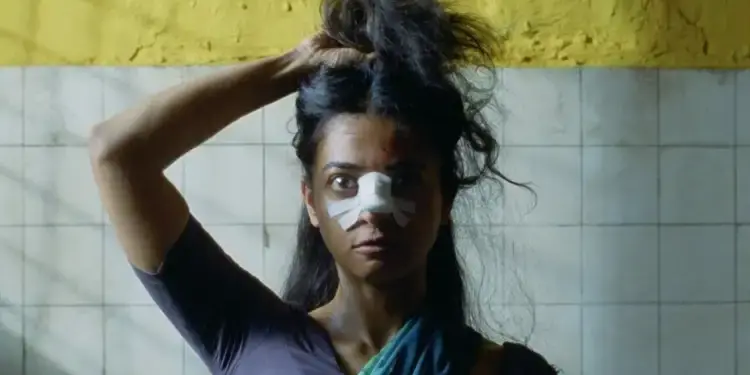Sister Midnight Follows the story of Uma, a young bride who finds herself in an arranged marriage with Gopal, a man she barely knows. Their common life begins in a tiny house, far from the expectations and dreams of UMA. From the first scenes, the latter is distinguished by its acerbic and vulgar attitude, far from the rigid expectations of a new Indian wife. Not knowing how to cook or manage domestic spending, she feels locked up in a role that does not correspond to her. Her situation is exacerbated by the presence of her husband, Gopal (Ashok Pathak), a gentle and reserved man whom she barely knows and who often returns drunk in the evening after work. The dynamics between them is marked by a palpable awkwardness, making their relationship all the more complex and fascinating.
Gopal leaves UMA alone all day, faced with domestic tasks for which it is not prepared. As boredom and loneliness invade her life, Uma decides to take matters into hand. She tries to adapt to her new domestic life. With the help of her neighbor Sheeta (Chhaya Kadam), she learns to hold her house and finds a work of night cleaning lady. These night getaways become an outlet for his overflowing imagination. She begins to have strange and whimsical visions: bright birds of her bed, goats appearing in the street. These hallucinations reflect his discomfort and his desire for escape.
Karan Kandhari quickly establishes a comic and visual atmosphere with a particular care given to the staging, editing and choreography. The comic scenes are punctuated by eclectic musical choices, ranging from Bengali folk to American punk and blues, adding an additional dimension to the authenticity and originality of the film. The director, based in London but of Indian origin, draws from a variety of cultural influences while offering an authentic representation of the working class of Mumbai, particularly in the quieter and intimate moments of the film.


As Uma rises, a dark transformation takes place in her. Kandhari inventively uses Stop-motion elements to illustrate the psychotic manifestations of his anxieties, creating striking images that blur the boundaries between reality and imagination. These sequences add a layer of complexity to narration, although their accumulation can sometimes make the film too dense and disturbing.
Sister Midnight It is not content to tell the personal story of Uma, he also criticizes the patriarchal standards of Indian society. Gopal, despite his faults, is also presented as a victim of the circumstances, adding a dimension of sympathy to his character. Karan Kandhari addresses the destructive nature of romance with sensitivity, but also with a critical look that exposes systemic injustices.
Karan Kandhari uses the film to explore deep social themes, including expectations placed on women in Indian society. UMA’s journey, from domestic oppression to self -assertion, is a harsh criticism of gender roles and suffocating traditions. However, the director balances this criticism with absurd humor and visual stylization that make the message both poignant and entertaining.
Sister Midnight is a film that refuses to comply with a single definition. He mixes drama, horror and comedy with a fluidity which reflects Uma’s refusal to accept the limits imposed by society. The film is a celebration of non-compliance and personal emancipation, carried by a masterful performance by Radhika Apt and a daring achievement by Karan Kandhari.
The first half of the film is marked by a sustained rhythm and an impressive visual creativity. However, towards the end, Sister Midnight Begins to lose his momentum, sparing in his style and his somewhat exaggerated narrative ambitions. The daring choices of the director end up creating a dissonance that keeps some spectators from the initial immersive experience. Comic mechanics, so effective at the beginning, becomes predictable and prevents the film from transforming to maintain its interest.
Despite these weaknesses, Sister Midnight There remains a deeply original and creative film, which is distinguished by its audacity and its refusal to comply with expectations. Radhika capable, in the role of UMA, delivers a masterful performance, proving once again its ability to play various and complex roles. Karan Kandhari, meanwhile, demonstrates a clear and perverse vision, but managed to arouse unexpected sympathy for his characters.


Radhika Apt, known for his ability to juggle between serious roles as in Women’s season (2015) From Leena Yadav and more wacky roles as in this film, offers a breathtaking performance here. She brilliantly embodies the progressive transformation of Uma, a submissive woman with wild and emancipated creature. Radhika Apt captures the shades of his character with a grace and an intensity that makes each scene captivating, whether in moments of funny comedy or dark drama.
Sister Midnight is a film which, despite its imperfections, stands out for its originality and its daring vision. Karan Kandhari breaks all the codes and offers a work that can only seduce with his creativity and his unconventional approach. A real invitation to explore the depths of the human soul through the prism of humor and surrealism. A must for those looking more than just entertainment in the cinema.
Neïla Driss









